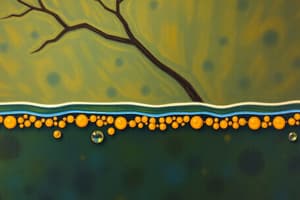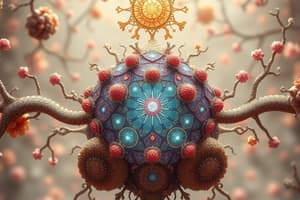Podcast
Questions and Answers
What characterizes tight junctions?
What characterizes tight junctions?
- They allow free flow of all solutes.
- They are intercellular attachments between cells. (correct)
- They are always permeable.
- They only exist in renal proximal tubules.
Which statement is true regarding facilitated diffusion?
Which statement is true regarding facilitated diffusion?
- It is carrier-mediated. (correct)
- It requires metabolic energy.
- It occurs against the electrochemical gradient.
- It can transport ions without any specific transport proteins.
What is true about the Na+ gradient in countertransport mechanisms?
What is true about the Na+ gradient in countertransport mechanisms?
- Na+ remains constant during transport.
- Countertransport does not require any active transport.
- Na+ is transported uphill.
- Countertransport uses the Na+ gradient for uphill transport. (correct)
Which type of transport does not require metabolic energy?
Which type of transport does not require metabolic energy?
In which situation would the Na+-K+ pump be inhibited?
In which situation would the Na+-K+ pump be inhibited?
What drives the movement of glucose into the intestinal or proximal tubule cell?
What drives the movement of glucose into the intestinal or proximal tubule cell?
Which statement about Na+-Ca2+ countertransport is true?
Which statement about Na+-Ca2+ countertransport is true?
What is the role of ATP in the Na+-Glucose cotransport mechanism?
What is the role of ATP in the Na+-Glucose cotransport mechanism?
What components primarily make up cell membranes?
What components primarily make up cell membranes?
Which type of substances can directly cross the lipid bilayer of a cell membrane?
Which type of substances can directly cross the lipid bilayer of a cell membrane?
In the Na+-Ca2+ countertransport mechanism, what happens to K+?
In the Na+-Ca2+ countertransport mechanism, what happens to K+?
What characterizes integral proteins in the cell membrane?
What characterizes integral proteins in the cell membrane?
Which of the following correctly describes secondary active transport?
Which of the following correctly describes secondary active transport?
What role do peripheral proteins play in the cell membrane?
What role do peripheral proteins play in the cell membrane?
What is the characteristic structure of phospholipids in the cell membrane?
What is the characteristic structure of phospholipids in the cell membrane?
What is a characteristic feature of carrier-mediated transport?
What is a characteristic feature of carrier-mediated transport?
Why does facilitated diffusion not require metabolic energy?
Why does facilitated diffusion not require metabolic energy?
Which of the following statements is true regarding stereospecificity in carrier-mediated transport?
Which of the following statements is true regarding stereospecificity in carrier-mediated transport?
In facilitated diffusion, how does the transport of glucose in muscle and adipose cells get inhibited?
In facilitated diffusion, how does the transport of glucose in muscle and adipose cells get inhibited?
What occurs when transport carriers become saturated?
What occurs when transport carriers become saturated?
What is the primary role of the Na+-K+ pump in cotransport mechanisms?
What is the primary role of the Na+-K+ pump in cotransport mechanisms?
In which type of transport do two solutes move in opposite directions across the cell membrane?
In which type of transport do two solutes move in opposite directions across the cell membrane?
What happens to Na+-glucose cotransport if the Na+-K+ pump is inhibited?
What happens to Na+-glucose cotransport if the Na+-K+ pump is inhibited?
Which of the following is an example of countertransport?
Which of the following is an example of countertransport?
Which statement is true regarding the Na+-glucose cotransport mechanism in the renal early proximal tubule?
Which statement is true regarding the Na+-glucose cotransport mechanism in the renal early proximal tubule?
What is a key characteristic of primary active transport?
What is a key characteristic of primary active transport?
What does the Na+, K+-ATPase typically transport in terms of stoichiometry?
What does the Na+, K+-ATPase typically transport in terms of stoichiometry?
Which of the following is a well-known inhibitor of the Na+, K+-ATPase?
Which of the following is a well-known inhibitor of the Na+, K+-ATPase?
Which process involves the transport of two solutes where one is transported downhill to provide energy for the other solute to be transported uphill?
Which process involves the transport of two solutes where one is transported downhill to provide energy for the other solute to be transported uphill?
What is the main role of the Ca2+-ATPase pump in cells?
What is the main role of the Ca2+-ATPase pump in cells?
Flashcards are hidden until you start studying
Study Notes
Transport Mechanisms in Cell Physiology
-
Na+-Glucose Cotransport (Symport):
- Involves Na+ moving from the lumen into intestinal or proximal tubule cells.
- Glucose is simultaneously transported into the cell from the lumen.
- Uses energy from primary active transport of Na+ to the blood, facilitated by Na+-K+ ATPase.
-
Na+-Ca2+ Countertransport (Antiport):
- Ca2+ moves from the cell to the lumen, utilizing Na+ that moves from blood into the cell.
- Relies on the direct ATP usage to pump Na+ out and K+ into the cell.
Cell Membranes
- Comprised of phospholipids and proteins, forming a lipid bilayer.
- Phospholipids contain hydrophilic heads and hydrophobic tails, creating a semi-permeable membrane.
- Lipid-soluble substances can cross membranes freely; water-soluble molecules require specific channels or carriers.
Types of Membrane Proteins
- Integral Proteins:
- Embedded within the membrane, include ion channels and transport proteins.
- Peripheral Proteins:
- Loosely attached by electrostatic interactions; not bound to membrane spans.
Intercellular Connections
- Tight Junctions:
- Connections between epithelial cells; can be either permeable or impermeable.
- Gap Junctions:
- Allow for intercellular communication and electrical coupling, essential for cell signaling.
Transport Across Cell Membranes
- Simple Diffusion:
- Passive transport; substances flow down their electrochemical gradient without energy or carriers.
- Facilitated Diffusion:
- Passive, carrier-mediated process allowing for the rapid transport of certain molecules down their gradient.
Carrier-Mediated Transport
- Involves facilitated diffusion, primary active transport, and secondary active transport.
- Exhibits stereospecificity, saturation, and competition among solutes.
Primary Active Transport
- Moves substances against their electrochemical gradients using ATP.
- Na+, K+-ATPase (Na+-K+ pump):
- Transports 3 Na+ out and 2 K+ into cells; inhibited by cardiac glycosides.
- Ca2+-ATPase and H+, K+-ATPase transport Ca2+ and H+ against gradients, respectively.
Secondary Active Transport
- Involves the coupling of two solutes; typically one moves downhill (Na+) to drive the uphill transport of another.
- Na+ cross-membrane gradient enables the secondary transport of other solutes, crucial in various physiological processes.
Key Definitions
- Cotransport (Symport): Solutes move in the same direction across the membrane.
- Countertransport (Antiport): Solutes move in opposite directions.
Studying That Suits You
Use AI to generate personalized quizzes and flashcards to suit your learning preferences.



